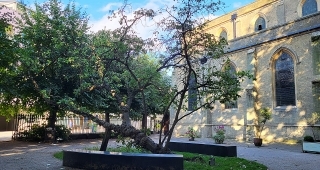Leaning over but flourishing in Fulham
I ARRIVED EARLY for a committee meeting of the Anglo-Albanian Association, which was being held in a house in Walham Grove in London’s Fulham district. It was a warm afternoon, and as I did not want to disturb our host by arriving too early, I sat on a bench in the small yard next to the north side of St Johns Church – a rather unexceptional example of early 19th century church architecture.

Soon, I noticed a tree in the middle of the yard. Its trunk was growing at about 30 degrees to the ground, and was supported by a wooden prop. Branches were growing out of the trunk, more or less vertically. There was a small commemorative notice at the base of the tree – where it had been planted originally. It bore the words:
“This mulberry tree was planted by His Worship the Mayor of Fulham Councillor JF Perotti JP on Victory Day June 8 1946”
On that day, celebrations were held in London to commemorate the Allied victory in WW2, the British Commonwealth, and the Empire. The Mayor, Mr Perotti, was a fitter at London Transport’s Lots Road electricity generating station.
In my mind, mulberry trees conjure up visions of silk growing and exotic landscapes of yesteryear. To be honest, until I saw the notice by the tree in the yard in Fulham, I would not have been able to identify a tree as being a mulberry. I stood up and examined it closely. To my great delight, I saw that the tree has berries. They looked like larger than average raspberries. I have read that when they ripen, they become darker in colour and resemble elongated blackberries.
I was curiously excited to find a mulberry tree with its fruit. I had not expected to find one in a busy part of Fulham. Mulberry trees have been grown in Britain since Roman times. One of the oldest surviving examples is in the garden of Canonbury Tower in Islington. It might have survived since the 16th century. There are several other slightly younger mulberry trees in London. So, the leaning example I saw in Fulham is a youngster on the scene.



